Arp Schnitger
| Arp Schnitger | |
|---|---|
| Born |
July 2, 1648 Schmalenfleth |
| Died |
July 28, 1719 (aged 71) Golzwarden (now in Brake, Lower Saxony) |
| Nationality | German |
| Occupation | Organ builder |
| Signature | |
 | |
Arp Schnitger (July 2, 1648 – July 28, 1719 (buried)) was a highly influential German organ builder.
Schnitger was born in Schmalenfleth, and was baptized on July 9, 1648, in Golzwarden. He was primarily active in Northern Europe, especially the Netherlands and Germany, where a number of his instruments survive to the present day; his organs can also be found as far away as Portugal and Brazil. He died in Neuenfelde, aged 71.
Notable examples of his work still in use include the organ at St. Pancratiuskirche, Neuenfelde, Hamburg (completed in 1688, his largest two-manual instrument); St. Jacobikirche, Hamburg (perhaps the most famous surviving Schnitger organ, completed in 1693); St. Martinikerk, Groningen, the Netherlands (1692); St. Ludgerikirche, Norden (1688); St. Cosmae und Damianikirche, Stade (Schnitger's first organ, completed in 1676 after the death of his teacher Berendt Huss); St. Peter und Paulkirche, Cappel (perhaps the most authentic of Schnitger's organs still in existence, originally in the Johanniskirche, Hamburg, 1680); and St. Michaeliskerk, Zwolle, the Netherlands (completed by his son Franz Caspar after Schnitger's death). Organs like this are credited with inspiring the renaissance in organ building during the early twentieth century, with a return to tracker action and smaller, more cohesive instruments, as distinct from the late-Romantic trend of extremely large symphonic organs. In particular, the organ at the Jacobikirche, Hamburg, played a pivotal role in the organ reform movement beginning in 1925, as a series of conferences taking place at historical organ sites in Germany and Alsace was inaugurated there.
The importance of Schnitger to the history of organ building cannot be overestimated. Schnitger was one of the most prolific builders of his time, completing more than 150 instruments and running several shops. His organ designs typify the essential North German organ: multiple divisions, usually with a rückpositif (division on the gallery rail, behind the player's back); large, independent pedal divisions, often placed in towers on either side of the main case; well-developed principal choruses in each division with abundant reeds, flutes, and mutation stops; and meantone temperament. All of these features could be found on North German organs prior to Schnitger's activity; Schnitger's genius lay in his ability to synthesize these elements into a prototypical style of organ building, and in his prolific output. The latter was made possible by his good business sense: Schnitger was one of the first builders to use cost-cutting measures on a large scale to ensure the affordability of organs for small village churches.
Many of Schnitger's landmark instruments were actually rebuilds or expansions of existing organs (as at St. Jacobikirche, Hamburg, a renovation and enlargement of an earlier instrument by Fritzsche, 1635). Often, the expansion of the pedal division required the addition of pedal towers on either side of the case. This feature has come to be one of the most-typically associated with the North German style, despite the fact that a majority of smaller organs did not have pedal towers.
A number of Schnitger's organs were featured on recordings by E. Power Biggs, who is generally credited with reintroducing them to modern listeners. More recently, Schnitger's organs can be heard on several recordings by German organist Harald Vogel. Schnitger's instruments in Groningen, Uithuizen, Noordbroek and Nieuw Scheemda were featured in the documentary Martinikerk Rondeau, in which Jurgen Ahrend, Cor Edskes and Bernhardt Edskes detail Schnitger's life and demonstrate his working methods. Schnitger's organs have also served as inspiration for many modern builders; GOArt, a Swedish organ building consortium, has even gone so far as to build an exact copy of a Schnitger organ for research purposes.
Surviving Schnitger organs
| year | town | church | picture | manuals | stops | original by Schnitger |
|---|---|---|---|---|---|---|
| 1668–75/88 | Stade (D) | St. Cosmae et Damiani | |
III/P | 42 | case, prospect, 35 stops (8 partly) |
| 1677–79 | Bülkau (D) | St. John the Baptist |  |
I | 10 (?) | case, prospect; today II/P/22 |
| 1678–79/1709 | Jork (D) | St. Matthias |  |
III/P | 35 | case, prospect; today II/P/22 |
| 1680 | Cappel (D) | St. Peter and Paul | 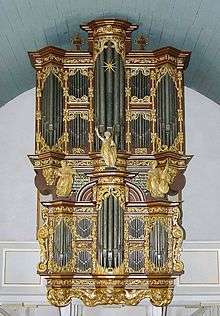 |
II/P | 30 | case, prospect, 18 stops, 10 other old stops re-used by Schnitger |
| 1678–82 | Oederquart (D) | St. Johannis | III/p | 28 | case, prospect; today II/P/17 | |
| 1682–83 | Lüdingworth (D) | St. Jacobi | _002.jpg) |
III/P | 35 | case, prospect, 14 stops (complete or partly), much old pipework reused by Schnitger (half of the organ) |
| 1684 | Elmshorn (D) | St. Nicolai | .jpg) |
II/P | 23 | case; today III/P/33 |
| 1686 | Hamburg-Bergstedt (D) | Ev. Church | 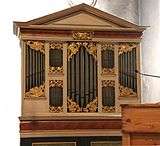 |
I | 8 | case, 2-3 stops |
| 1687 | Blankenhagen (D) | Village Church |  |
II/p | 12 | case, 4-5 stops |
| 1687 | Steinkirchen (D) | St. Nicolai et Martini | .jpg) |
II/P | 28 | case, prospect, 13 stops, 8 other partly |
| 1683–88 | Hamburg-Neuenfelde (D) | St. Pankratius |  |
II/P | 34 | case, prospect, 18 stops |
| 1688 | Mittelnkirchen (D) | St. Bartholomäus | .jpg) |
II/p | 22 | 6-8 stops; today II/P/32 |
| 1688–90 | Hollern (D) | St. Mauritius | 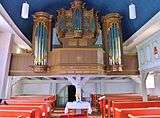 |
II/P | 24 | case, prospect, 13 stops (complete or partly) |
| 1686–88/1691–92 | Norden (D) | St. Ludgeri | |
III/P | 46 | case, 13 stops, 8 old stops reused by Schnitger |
| 1691–92 | Groningen (NL) | Martinikerk (Groningen) | 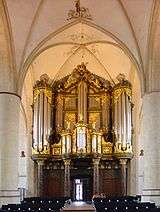 |
III/P | 53 | case of the pedal, prospect, 6 stops, other old stops reused by Schnitger; today III/P/52 |
| 1689–93 | Hamburg (D) | St. Jacobi |  |
IV/P | 60 | 43 stops (complete or partly), some reused by Schnitger → Schnitger organ (Hamburg) |
| 1693 | Groningen (NL) | Pelstergasthuiskerk | 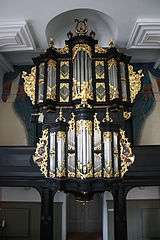 |
II/p | 20 | case, 2 register (7 partly) |
| 1693 | Eutin (D) | castle |  |
I | 9 | case |
| 1693–94 | Grasberg (D) | Luth. Church |  |
II/P | 21 | case, 14 stops |
| 1695–96 | Noordbroek (NL) | Hervormde Kerk |  |
II/P | 20 | case, 10-11 stops; today II/P/24 |
| 1695–96 | Harkstede (NL) | Hervormde Kerk | 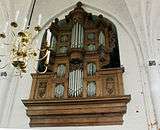 |
I | 7 | case, prospect, 5 stops; today I/p/9 (10) |
| 1696–97 | Peize (NL) | Hervormde Kerk | |
II/P | 22 | case, prospect, 4-6 stops, old stops reused by Schnitger |
| 1697–98 | Strückhausen (D) | St. Johannes |  |
II/p | 12 | case of the Hauptwerk, 2 stops; today II/P/15 |
| 1697–98 | Dedesdorf (D) | St. Laurentius | 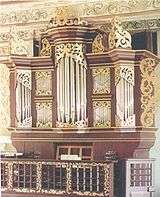 |
II/p | 12 | case of the manuals, 10 stops; today II/P/18 |
| 1697–98 | Golzwarden (D) | St. Bartholomäus | 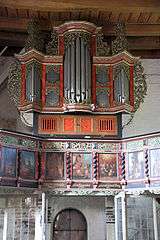 |
II/P | 20 | case; today II/P/22 |
| 1699 | Nieuw-Scheemda (NL) | Hervormde Kerk |  |
I/p | 8 | case, 4-6 stops |
| 1696–99 | Mensingeweer (NL) | Hervormde Kerk | 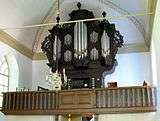 |
I | 9 | case, prospekt, 6 stops |
| 1699 | Ganderkesee (D) | St. Cyprian und Cornelius | 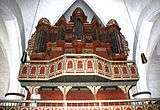 |
II/p | 16 | case, prospect, 9 stops; today II/P/22 |
| 1700–01 | Uithuizen (NL) | Hervormde Kerk |  |
II/P | 28 | case, 19 stops, 6 others partly |
| 1701 | Maia, Portugal | Monastery Church San Salvador |  |
II | 12 | case, 11 stops |
| 1701 | Mariana, Minas Gerais (Brazil) | Cathedral Nossa Senhora da Assunção |  |
II/p | 18 | case, prospect, 14 stops (complete or partly); probably by Schnitger's co-worker Heinrich Hullenkampf[1] |
| 1699–1702 | Clausthal-Zellerfeld (D) | St. Salvatoris | 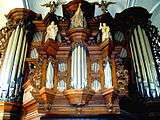 |
III/P | 55 | case; today II/P/29 |
| 1700–02 | Groningen (NL) | Der Aa-kerk | |
III/P | 32 | case, prospect, ca. 13 stops, 10 old stops reused by Schnitger; today III/P/40 |
| 1702 | Estebrügge (D) | St. Martin |  |
II/P | 34 | case |
| 1704 | Eenum (NL) | Hervormde Kerk | 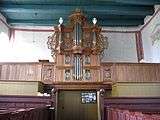 |
I | 10 | case, prospect, 4-6 stops; today I/p/10 |
| 1704 | Godlinze (NL) | Hervormde Kerk | 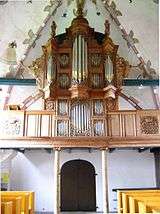 |
II/p (?) | 16 | case, prospect, 8-9 stops; today I/p/12 |
| 1705 | Accum (D) | St. Willehad | 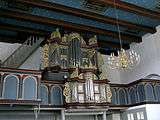 |
II/p | 14 | case |
| 1707–08 | Lenzen (D) | St. Katharinen | 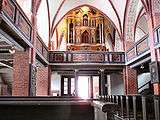 |
II/P | 27 | case partly, 2-3 stops |
| 1707–08 | Hamburg-Ochsenwerder (D) | St. Pankratius |  |
II/P | 30 | case, prospect, 5-11 stops; today II/P/24 |
| 1709–10 | Weener (D) | St.-Georg |  |
II/p | 22 | case, 6 stops; today II/P/29 |
| 1710–11 | Pellworm (D) | Old Church | |
II/P | 24 | case, 11 stops (complete or partly) |
| 1710–11 | Sneek (NL) | Grote of Martinikerk |  |
III/P | 36 | case, prospect, 10 stops (complete or partly) |
| 1711 | Ferwert (NL) | Hervormde Kerk |  |
II/P | 26 | 5 stops |
| 1710–13 | Abbehausen (D) | St. Laurentius |  |
II/P | 24 | case, prospect, 2 stops |
| 1715–16 | Faro, Portugal | Cathedral | |
II | 22 | probably by Schnitger's co-worker Heinrich Hullenkampf[1] |
| 1714–16 | Rendsburg (D) | Christuskirche | 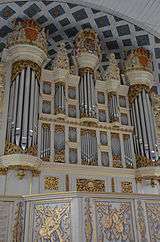 |
II/P | 29 | case, 4 stops; today IV/P/51 |
| 1715–19 | Itzehoe (D) | St. Laurentii | 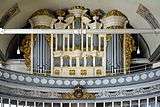 |
IV/P | 43 | case, prospect; today IV/P/58 |
| 1719–21 | Zwolle (NL) | Grote of Sint-Michaëlskerk | |
IV/P | 64 | case, main part of the stops; finished by the sons Franz Caspar Schnitger and Johann Georg Schnitger |
See also
References
- Peggy Kelley Reinburg (1982). Arp Schnitger, organ builder; catalyst for the centuries. Bloomington: Indiana University Press. ISBN 978-0-253-30927-3.
External links
| Wikimedia Commons has media related to Arp Schnitger. |
- Organs of Arp Schnitger
- Arp Schnitger, Organ Builder – Organ Itinerary. In Google Earth Community.
- http://www.schnitgerorgel.de
- http://www.fuguestatefilms.co.uk/martinikerk